Infantry Accounts of Mittelbau Dora Concentration Camp
Item
Title
Infantry Accounts of Mittelbau Dora Concentration Camp
Description
A web article containing first-hand accounts from soldiers of the 104th Infantry Division who, along with the 3rd Armored Division and the 9th Infantry Division, liberated the Mittelbau Dora concentration camp on April 11, 1945. The accounts come from interviews in Leo Arthur Hoegh's book, "Timberwolf Tracks: The History Of The 104th Infantry Division, 1942-1945". The accounts that are quoted in this article came from Sergeant Ragene Ferris of the 329th Medical Batallion, and Leon Karalokian of the 104th Signal Company.
There are highlighted portions of the article, those being the following excerpts:
"In a caravan of trucks we rushed into a job which proved unbelievable to an American: a job distasteful and sobering: one created by the fanatical inhuman Nazi machine. We found out the full meaning of the words ‘Concentration Camp.’"
"It was like stepping into the Dark Ages to walk into one of these cellar-cells and seek out the living; like walking into a world apart and returning to bring these shadow-men into the environment of a clean American ambulance."
"The very few walking skeletons able to stand wandered about dazedly in the now familiar striped uniforms, bodies shrunken, white faces blood drained, reaching for the hands of their liberators as they shed their tears. Battle-hardened men of the 104th wept too."
"There are those who now maintain Hitler’s holocaust never occurred. Would that it was possible to take the doubters by the hand, back through the years, and point out the tragedy of this minor concentration camp!"
There are highlighted portions of the article, those being the following excerpts:
"In a caravan of trucks we rushed into a job which proved unbelievable to an American: a job distasteful and sobering: one created by the fanatical inhuman Nazi machine. We found out the full meaning of the words ‘Concentration Camp.’"
"It was like stepping into the Dark Ages to walk into one of these cellar-cells and seek out the living; like walking into a world apart and returning to bring these shadow-men into the environment of a clean American ambulance."
"The very few walking skeletons able to stand wandered about dazedly in the now familiar striped uniforms, bodies shrunken, white faces blood drained, reaching for the hands of their liberators as they shed their tears. Battle-hardened men of the 104th wept too."
"There are those who now maintain Hitler’s holocaust never occurred. Would that it was possible to take the doubters by the hand, back through the years, and point out the tragedy of this minor concentration camp!"
transcription
“This is what hell must be like” – French survivor Jean Mialet
Breaking out of the Remagen Bridgehead on 25 March, 1945, the 104th Infantry Division, as part of the U.S. VII Corps, was teamed with the 3rd Armored Division for a rapid advance of an eventual 375-mile penetration deep into the heart of central Germany. Hitler’s once mighty war machine was crumbling, but counter attacks and stubborn pockets of resistance, by the hungry and desperate enemy, continued as tongue-twisting towns and villages like Holzhausen, Niederingelbach, Dalwigksthal, Strasseberbach & Eibelshausen appeared and were soon overrun. In black forbidding nights and gray days, often sullen with the slow, cold drizzle of rain, the thrust continued with Easter Sunday and April Fool’s Day practically unnoticed. The 193-mile segment from the Rhine to Paderborn had taken only nine days with captured Wehrmacht vehicles and even barnyard carts supplementing more conventional means of military transport of the relentless push to the east.
The morning of 11 April dawned with yet another strangely named town to be reckoned with. Easier to pronounce, but impossible to forget, Nordhausen, home of the Mittelbau-Dora Concentration Camp, was first viewed as just another spot on the map, but became a name to be stamped in the annuals of Timberwolf and 3rd Armored history – permanently engraved in the hearts and memories of all present.
The history of the 104th Infantry Division, Timberwolf Tracks, relates the long to be remembered and heart gripping story from first-hand accounts:
“In Nordhausen the Division found a large German concentration camp for political prisoners, discovering 5,000 corpses among the 6,000 inmates in various stages of decay. The corpses were scattered throughout the buildings and grounds of the large camp and all of them appeared to have been starved to such an extent that they were mere skeletons wrapped in skin. Most of the bodies apparently lay untouched since death had overtaken them, but some were stacked like cordwood under stairways. In almost all bunkers and buildings the living were found lying among the dead. In one corner was a pile of arms and legs. All medical personnel that could be spared in the Division were rushed to the scene to give medical aid. Hundreds of the male citizens of the town were ordered to the camp, where under guard, they worked several days carrying litter cases and collecting corpses by hand. They dug mass graves on a prominent hill near the camp and carried the corpses through the town to the graves.”
Sergeant Ragene Farris of the 329th Medical Battalion, 104th Infantry Division, was there and explained the impact of the gruesome sights at Nordhausen upon the men of the 104th:
“For days and weeks, even months afterwards, the word Nordhausen brought us a mixed response of emotions. We were battle-tired and combat-wise medics, and we thought there was nothing left in the books we didn’t know. Yet in a short period of two days I and many others of the Division saw and lived a story we shall never forget.
The strongly Nazified town of Nordhausen fell before air-armor and night attack on 11 April. Our S-2 Captain Johnson, brought the news that we were needed to evacuate patients from a concentration camp in one of the large factory areas of the city. Lying among the multitudes of dead were reported to be a few living ‘beings’, and with quick medical attention some might be saved. Colonel Taggart called into action, early 12 April, the litter bearers and medical technicians as well as any other men available from duties with our own wounded. In a caravan of trucks we rushed into a job which proved unbelievable to an American: a job distasteful and sobering: one created by the fanatical inhuman Nazi machine. We found out the full meaning of the words ‘Concentration Camp.’
Bombs had ground flesh and bones into the cement floor. Rows upon rows of skin-covered skeletons met our eyes. Men lay as they starved, discolored, and lying in indescribable human filth. Their striped coats and prison numbers hung to their frames as a last token of those who enslaved and killed them. In this large motor shop there were no living beings; only the distorted dread. We went to the stairs and under the casing were neatly piled about seventy-five bodies, a sight I could never erase from memories. Dying on the second floor were, upon later count, about twenty-five men or half-men. Some of these, lying in double-decked wooden bedsteads, were grotesquely still, yet hanging tenaciously to life’s breath. They were still alive.
We saw, at a quick survey, this was to be as big a medical job as we had been called upon to do. Speed would save lives, so we fell into a day of evacuation, hospitalization, and feeding, unparalleled to any day of combat. It became evident almost immediately that our few medics could not evacuate hundreds of patients, set up improvised hospital wards, and feed many mouths without help. So under the leadership of Colonel Jones and Chaplain Steinbeck, who spoke German, we rounded up German civilians on the streets of this Nazi city as we saw them. The order was, “You will work.” In this manner, about one hundred German litter bearers were gathered up and rushed to the scene.
I was accosted by a less emaciated prisoner who asked if anyone spoke French. When I answered, he brightened and related that a group of Frenchmen had established a small colony in the large cellar of another building, and would I please bring aid to them. This was my signal to get into gear, and off across bomb-cratered grounds we picked our way to this particular building. There were many bodies strewn about. One girl in particular I noticed; I would say she was about seventeen years old. She lay there where she had fallen, gangrened and naked. In my own thoughts I choked up – couldn’t quite understand how and why war could do these things. But my job crowded out any serious impressions at the moment. Only later I thought of what I had seen. Now we approached the cellar stairs leading to the French group. I heard ‘monsieur’ very softly, and at my feet, lying as if dead, was a cadaverous man; he raised up and said, in beautiful Parisian French, that if he were stronger he would honor me by the traditional kiss on either cheek. I learned that he was a captain from France’s famous Saint Cyr Military Academy and had received particularly sadistic attention from the SS Troopers. He looked to be seventy-five but was only forty-five. His last step had taken him to the edge of the stairs. He had gone as far as possible to escape the fury of war when the Americans fought into Nordhausen. He lay dust-covered, where he had nearly been crushed by falling walls – yet he displayed remarkable discipline and composure. With care, he was lifted upon a litter and taken to our waiting ambulances. I often wonder if he made it back to life, and if he had ever been able to tell his story.
We went downstairs into a filth indescribable, accompanied by a horrible dead-rot stench. There in beds of crude wood I saw men too weak to move dead comrades from their side. One hunched-down French boy was huddled up against a dead comrade, as if to keep warm, having no concept that the friend had been dead two or three days and unable to move his own limbs. There were others, in dark cellar rooms, lying in disease and filth, being eaten away by diarrhea and malnutrition. It was like stepping into the Dark Ages to walk into one of these cellar-cells and seek out the living; like walking into a world apart and returning to bring these shadow-men into the environment of a clean American ambulance. In one bomb crater lay about twenty bodies. We pulled three or four feebly struggling living ones from the bottom of the pile; they had been struggling for five or six days to get out but the weight of the other bodies piled on them had been too much for their starved, emaciated frames. We saw those on a bank who had been cut down by machine guns in trying to escape the fury of the guards. I saw one man feebly stagger to attention and salute us as tears slowly trickled down his cheeks. Too weak to walk, this man was genuinely moved to pay tribute to those who were helping him – showing him the first kind act in years. A few men were able to walk on their swollen, bulging feet; they had no shoes and they were unbelievably dirty. There were lash marks on many of their scantily covered backs – definite proof of beatings and floggings by their inhuman guards. One Parisian business told me he had been kicked and beaten repeatedly. He was comparatively healthy, as he had been in camp only three months. He told me that many of the 3,000 dead in the camp had been worked, beaten and forced to top speed until they could work no longer, after which they were starved off or killed outright.”
"Everything that is now in space had its origins here, not in America or Russia." – Rene Steenbeke
Two miles northwest of Nordhausen a huge underground V-bomb factory was discovered. It was two miles in length, with two large tunnels approximately fifty feet in width and height, connected laterally by forty-eight smaller tunnels. From 1943 until 1945, 60,000 prisoners had toiled here in production of V-1 and V-2 bombs*. Of these, 20,000 had died from various causes including starvation, fatigue and execution. The SS was in charge of the factory and the camp, with German criminals as strawbosses. Workers were executed at the slightest suggestion of sabotage. No workers had ever been allowed to leave the camp and when they became too weak to work, they were abandoned to die and their bodies burned at the crematorium within the grounds. Reports indicated that approximately one hundred bodies were cremated per day, and there were about thirty corpses piled on the ground awaiting such treatment when the 104th arrived. The bodies showed many signs of beating, starvation and torture.
More than a half-century later, the memories of Nordhausen remain fixed in the minds of the 104th Division Timberwolves who were there and witnessed that terrible evidence of atrocity. Leon Karalokian of the 104th Signal Company is among those who can’t forget:
“Nordhausen was to provide a ghastly traumatic experience never to be forgotten by those who passed through it. On the ground laid out in neat rows were an estimated thousand decaying corpses ranging from the near skeletonized to the newly dead. In the building bedding on straw side by side in indescribable filth lay the emaciated living, too weak to move away from the dead. Nordhausen did not have the huge inmate of Auschwitz. Nor did it have the gas chambers of Dachau or Buchenwald, a refinement apparently reserved for Jewish victims who were on the bottom of the insane Nazi scale of values. Its crematory, though small, was able to convert 100 of yesterday’s men to a heap of ashes each day. The 5,000 victims here, dead and alive, were predominantly Polish slave workers, with some French, conscripted to turn out in enormous underground factories the deadly supersonic V-2 rockets. The full medical resources of the division and from other units did all possible for the living. The very few walking skeletons able to stand wandered about dazedly in the now familiar striped uniforms, bodies shrunken, white faces blood drained, reaching for the hands of their liberators as they shed their tears. Battle-hardened men of the 104th wept too.
The emotional impact was heavy on all who were witness to these incidents but considerably more so on this writer. As an American of Armenian ancestry I had been brought up, as have virtually all first and second generation Americans of similar background, on the eye witnessed horror stories of an even more sanguine genocide in Turkey three decades earlier. Massacre was the word here, knives and bullets for the males, desert death marches, hunger and rape for the women and children. A million or more Armenian lives destroyed at the whim of those who ruled the old Turkish Otterman Empire. Staring at the human debris on the ground awaiting burial I asked myself, ‘Is this what is meant by genocide? Was this also the fate of the grandparents, uncles and aunts I had never known?’.
Time dulls the impact of events. There are those who now maintain Hitler’s holocaust never occurred. Would that it was possible to take the doubters by the hand, back through the years, and point out the tragedy of this minor concentration camp! Sobered and drained each of us eventually left the area, in the words of a poet a sadder but wiser man.”
Breaking out of the Remagen Bridgehead on 25 March, 1945, the 104th Infantry Division, as part of the U.S. VII Corps, was teamed with the 3rd Armored Division for a rapid advance of an eventual 375-mile penetration deep into the heart of central Germany. Hitler’s once mighty war machine was crumbling, but counter attacks and stubborn pockets of resistance, by the hungry and desperate enemy, continued as tongue-twisting towns and villages like Holzhausen, Niederingelbach, Dalwigksthal, Strasseberbach & Eibelshausen appeared and were soon overrun. In black forbidding nights and gray days, often sullen with the slow, cold drizzle of rain, the thrust continued with Easter Sunday and April Fool’s Day practically unnoticed. The 193-mile segment from the Rhine to Paderborn had taken only nine days with captured Wehrmacht vehicles and even barnyard carts supplementing more conventional means of military transport of the relentless push to the east.
The morning of 11 April dawned with yet another strangely named town to be reckoned with. Easier to pronounce, but impossible to forget, Nordhausen, home of the Mittelbau-Dora Concentration Camp, was first viewed as just another spot on the map, but became a name to be stamped in the annuals of Timberwolf and 3rd Armored history – permanently engraved in the hearts and memories of all present.
The history of the 104th Infantry Division, Timberwolf Tracks, relates the long to be remembered and heart gripping story from first-hand accounts:
“In Nordhausen the Division found a large German concentration camp for political prisoners, discovering 5,000 corpses among the 6,000 inmates in various stages of decay. The corpses were scattered throughout the buildings and grounds of the large camp and all of them appeared to have been starved to such an extent that they were mere skeletons wrapped in skin. Most of the bodies apparently lay untouched since death had overtaken them, but some were stacked like cordwood under stairways. In almost all bunkers and buildings the living were found lying among the dead. In one corner was a pile of arms and legs. All medical personnel that could be spared in the Division were rushed to the scene to give medical aid. Hundreds of the male citizens of the town were ordered to the camp, where under guard, they worked several days carrying litter cases and collecting corpses by hand. They dug mass graves on a prominent hill near the camp and carried the corpses through the town to the graves.”
Sergeant Ragene Farris of the 329th Medical Battalion, 104th Infantry Division, was there and explained the impact of the gruesome sights at Nordhausen upon the men of the 104th:
“For days and weeks, even months afterwards, the word Nordhausen brought us a mixed response of emotions. We were battle-tired and combat-wise medics, and we thought there was nothing left in the books we didn’t know. Yet in a short period of two days I and many others of the Division saw and lived a story we shall never forget.
The strongly Nazified town of Nordhausen fell before air-armor and night attack on 11 April. Our S-2 Captain Johnson, brought the news that we were needed to evacuate patients from a concentration camp in one of the large factory areas of the city. Lying among the multitudes of dead were reported to be a few living ‘beings’, and with quick medical attention some might be saved. Colonel Taggart called into action, early 12 April, the litter bearers and medical technicians as well as any other men available from duties with our own wounded. In a caravan of trucks we rushed into a job which proved unbelievable to an American: a job distasteful and sobering: one created by the fanatical inhuman Nazi machine. We found out the full meaning of the words ‘Concentration Camp.’
Bombs had ground flesh and bones into the cement floor. Rows upon rows of skin-covered skeletons met our eyes. Men lay as they starved, discolored, and lying in indescribable human filth. Their striped coats and prison numbers hung to their frames as a last token of those who enslaved and killed them. In this large motor shop there were no living beings; only the distorted dread. We went to the stairs and under the casing were neatly piled about seventy-five bodies, a sight I could never erase from memories. Dying on the second floor were, upon later count, about twenty-five men or half-men. Some of these, lying in double-decked wooden bedsteads, were grotesquely still, yet hanging tenaciously to life’s breath. They were still alive.
We saw, at a quick survey, this was to be as big a medical job as we had been called upon to do. Speed would save lives, so we fell into a day of evacuation, hospitalization, and feeding, unparalleled to any day of combat. It became evident almost immediately that our few medics could not evacuate hundreds of patients, set up improvised hospital wards, and feed many mouths without help. So under the leadership of Colonel Jones and Chaplain Steinbeck, who spoke German, we rounded up German civilians on the streets of this Nazi city as we saw them. The order was, “You will work.” In this manner, about one hundred German litter bearers were gathered up and rushed to the scene.
I was accosted by a less emaciated prisoner who asked if anyone spoke French. When I answered, he brightened and related that a group of Frenchmen had established a small colony in the large cellar of another building, and would I please bring aid to them. This was my signal to get into gear, and off across bomb-cratered grounds we picked our way to this particular building. There were many bodies strewn about. One girl in particular I noticed; I would say she was about seventeen years old. She lay there where she had fallen, gangrened and naked. In my own thoughts I choked up – couldn’t quite understand how and why war could do these things. But my job crowded out any serious impressions at the moment. Only later I thought of what I had seen. Now we approached the cellar stairs leading to the French group. I heard ‘monsieur’ very softly, and at my feet, lying as if dead, was a cadaverous man; he raised up and said, in beautiful Parisian French, that if he were stronger he would honor me by the traditional kiss on either cheek. I learned that he was a captain from France’s famous Saint Cyr Military Academy and had received particularly sadistic attention from the SS Troopers. He looked to be seventy-five but was only forty-five. His last step had taken him to the edge of the stairs. He had gone as far as possible to escape the fury of war when the Americans fought into Nordhausen. He lay dust-covered, where he had nearly been crushed by falling walls – yet he displayed remarkable discipline and composure. With care, he was lifted upon a litter and taken to our waiting ambulances. I often wonder if he made it back to life, and if he had ever been able to tell his story.
We went downstairs into a filth indescribable, accompanied by a horrible dead-rot stench. There in beds of crude wood I saw men too weak to move dead comrades from their side. One hunched-down French boy was huddled up against a dead comrade, as if to keep warm, having no concept that the friend had been dead two or three days and unable to move his own limbs. There were others, in dark cellar rooms, lying in disease and filth, being eaten away by diarrhea and malnutrition. It was like stepping into the Dark Ages to walk into one of these cellar-cells and seek out the living; like walking into a world apart and returning to bring these shadow-men into the environment of a clean American ambulance. In one bomb crater lay about twenty bodies. We pulled three or four feebly struggling living ones from the bottom of the pile; they had been struggling for five or six days to get out but the weight of the other bodies piled on them had been too much for their starved, emaciated frames. We saw those on a bank who had been cut down by machine guns in trying to escape the fury of the guards. I saw one man feebly stagger to attention and salute us as tears slowly trickled down his cheeks. Too weak to walk, this man was genuinely moved to pay tribute to those who were helping him – showing him the first kind act in years. A few men were able to walk on their swollen, bulging feet; they had no shoes and they were unbelievably dirty. There were lash marks on many of their scantily covered backs – definite proof of beatings and floggings by their inhuman guards. One Parisian business told me he had been kicked and beaten repeatedly. He was comparatively healthy, as he had been in camp only three months. He told me that many of the 3,000 dead in the camp had been worked, beaten and forced to top speed until they could work no longer, after which they were starved off or killed outright.”
"Everything that is now in space had its origins here, not in America or Russia." – Rene Steenbeke
Two miles northwest of Nordhausen a huge underground V-bomb factory was discovered. It was two miles in length, with two large tunnels approximately fifty feet in width and height, connected laterally by forty-eight smaller tunnels. From 1943 until 1945, 60,000 prisoners had toiled here in production of V-1 and V-2 bombs*. Of these, 20,000 had died from various causes including starvation, fatigue and execution. The SS was in charge of the factory and the camp, with German criminals as strawbosses. Workers were executed at the slightest suggestion of sabotage. No workers had ever been allowed to leave the camp and when they became too weak to work, they were abandoned to die and their bodies burned at the crematorium within the grounds. Reports indicated that approximately one hundred bodies were cremated per day, and there were about thirty corpses piled on the ground awaiting such treatment when the 104th arrived. The bodies showed many signs of beating, starvation and torture.
More than a half-century later, the memories of Nordhausen remain fixed in the minds of the 104th Division Timberwolves who were there and witnessed that terrible evidence of atrocity. Leon Karalokian of the 104th Signal Company is among those who can’t forget:
“Nordhausen was to provide a ghastly traumatic experience never to be forgotten by those who passed through it. On the ground laid out in neat rows were an estimated thousand decaying corpses ranging from the near skeletonized to the newly dead. In the building bedding on straw side by side in indescribable filth lay the emaciated living, too weak to move away from the dead. Nordhausen did not have the huge inmate of Auschwitz. Nor did it have the gas chambers of Dachau or Buchenwald, a refinement apparently reserved for Jewish victims who were on the bottom of the insane Nazi scale of values. Its crematory, though small, was able to convert 100 of yesterday’s men to a heap of ashes each day. The 5,000 victims here, dead and alive, were predominantly Polish slave workers, with some French, conscripted to turn out in enormous underground factories the deadly supersonic V-2 rockets. The full medical resources of the division and from other units did all possible for the living. The very few walking skeletons able to stand wandered about dazedly in the now familiar striped uniforms, bodies shrunken, white faces blood drained, reaching for the hands of their liberators as they shed their tears. Battle-hardened men of the 104th wept too.
The emotional impact was heavy on all who were witness to these incidents but considerably more so on this writer. As an American of Armenian ancestry I had been brought up, as have virtually all first and second generation Americans of similar background, on the eye witnessed horror stories of an even more sanguine genocide in Turkey three decades earlier. Massacre was the word here, knives and bullets for the males, desert death marches, hunger and rape for the women and children. A million or more Armenian lives destroyed at the whim of those who ruled the old Turkish Otterman Empire. Staring at the human debris on the ground awaiting burial I asked myself, ‘Is this what is meant by genocide? Was this also the fate of the grandparents, uncles and aunts I had never known?’.
Time dulls the impact of events. There are those who now maintain Hitler’s holocaust never occurred. Would that it was possible to take the doubters by the hand, back through the years, and point out the tragedy of this minor concentration camp! Sobered and drained each of us eventually left the area, in the words of a poet a sadder but wiser man.”
Date
Page Last Updated: April 29, 1998
Mittelbau Dora Liberated: April 11, 1945
Mittelbau Dora Liberated: April 11, 1945
Language
English
Source
From AMM's personal archive
Subject
The Way the Crow Flies
Item sets
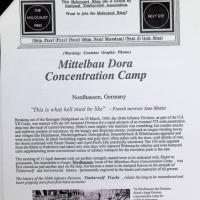 Infantry Accounts of Mittelbau Dora Concentration Camp 1
Infantry Accounts of Mittelbau Dora Concentration Camp 1 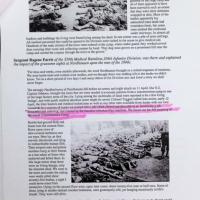 Infantry Accounts of Mittelbau Dora Concentration Camp 2
Infantry Accounts of Mittelbau Dora Concentration Camp 2 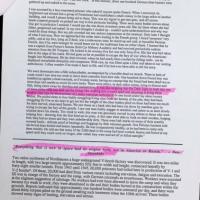 Infantry Accounts of Mittelbau Dora Concentration Camp 3
Infantry Accounts of Mittelbau Dora Concentration Camp 3 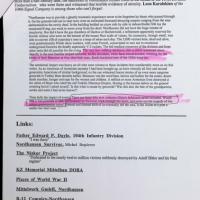 Infantry Accounts of Mittelbau Dora Concentration Camp 4
Infantry Accounts of Mittelbau Dora Concentration Camp 4 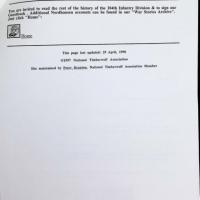 Infantry Accounts of Mittelbau Dora Concentration Camp 5
Infantry Accounts of Mittelbau Dora Concentration Camp 5